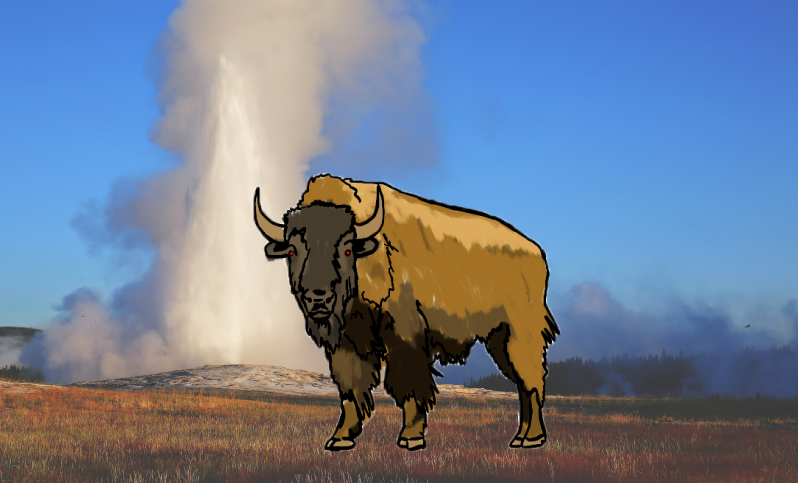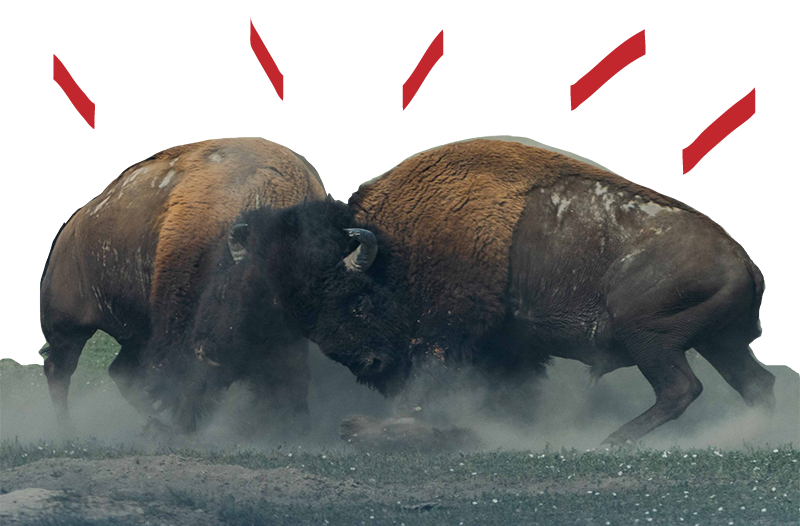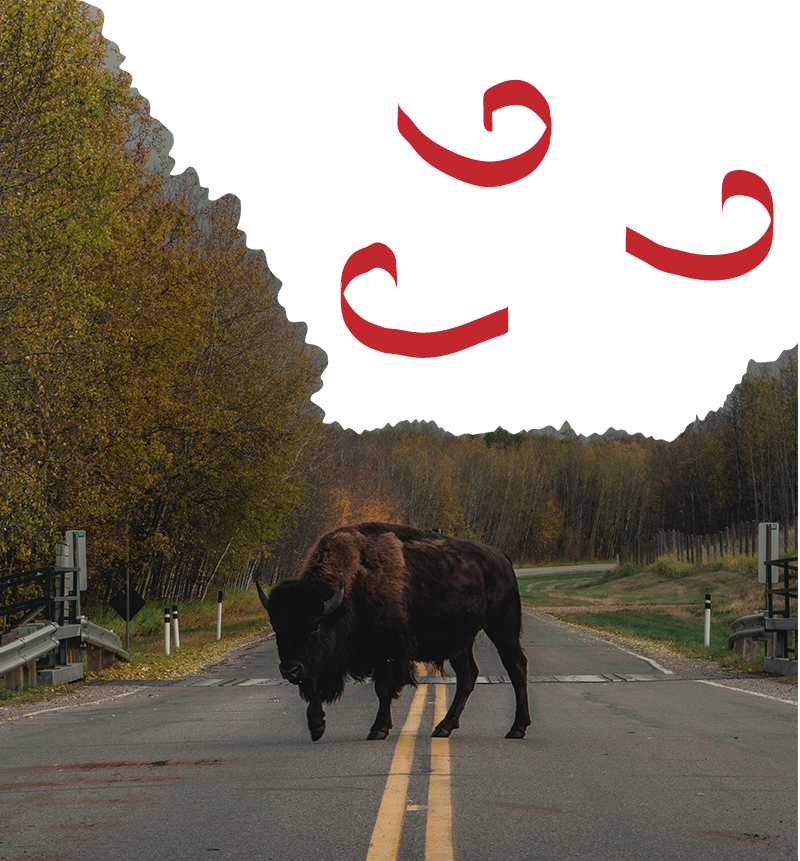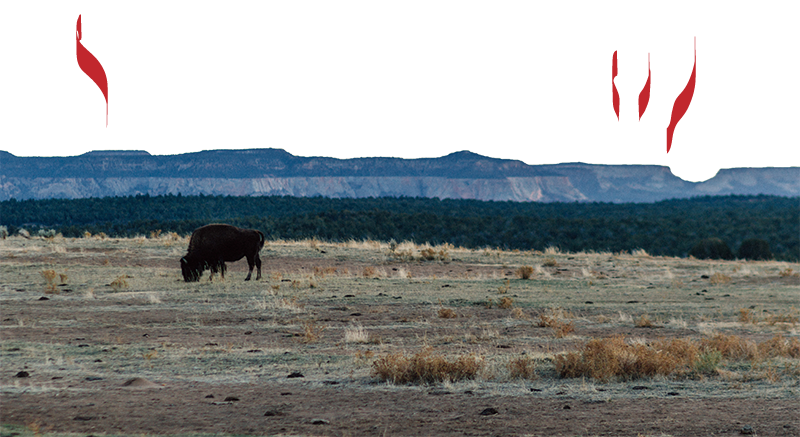Before Yellowstone, I never thought about the murderous qualities of buffalo. After Yellowstone, it was all I could think about.
In the fall of 2007, my then-girlfriend Katelyn and I were on an epic cross-country road trip. Passing through Wyoming, we made a detour to visit America’s oldest national park for a few days. As we drove up to the main gate, we were stopped at a booth by a park ranger in a wide-brimmed hat. “Is this your first visit to Yellowstone?” she asked.
“It sure is!” I answered. She nodded and handed over a small packet of papers that Katelyn flipped through as we drove into the park. It contained all of the expected materials: a detailed map, a large spread on various wildlife, a leaflet on camping regulations.
Then Katelyn pulled out a bright yellow flier that made us glance at each other, horrified. It was an illustration of a hapless park visitor, arms and legs outstretched, mouth in a round “O,” being launched into the air by a hulking buffalo. The beast’s sharp horns were inches from the man’s rump. “WARNING! MANY VISITORS HAVE BEEN GORED BY BUFFALO,” the page screamed in bold, capital type, “These animals may appear tame but are wild, unpredictable, and dangerous. DO NOT APPROACH BUFFALO.”
We sat in the idling car for several moments, staring at the flier. I knew that wild animals could often be erratic, but in my mind, “dangerous animals” were consigned to the usual suspects, built up by years of media portrayal. Sharks, bears, crocodiles, birds of prey, dinosaurs — those sorts of things. I never would have considered buffalo to be among them. They were supposed to be docile. Wasn’t “Home on the Range” all about yearning for a home in their vicinity?
Yet this new knowledge was disconcerting. I had only been at Yellowstone for 20 seconds, and already the list of potential things in the world that could kill me had grown.
“Should we stay in a Motel 6?” Katelyn asked. We planned on camping.
“Oh come on, it can’t be that bad,” I was unsure which of us I was trying harder to convince. “As long as we keep away from them, I’m sure we’ll be fine.”
We drove on, trying to put the unsettling image behind us.
That soon proved much easier said than done. Yellowstone spared no expense ensuring that a healthy fear of bison was buried deep into the psyche of every visitor who entered the park (although bison and buffalo are technically two different genera, the names are often used interchangeably and have been for hundreds of years).
At the Visitor’s Center, Katelyn and I spent 30 minutes watching an introductory video. The narrator explained the history of Yellowstone, from its role in the late nineteenth-century gold rush to the establishment of the national park system in 1871. There were sweeping aerial shots of lavish forest vegetation, scientific explanations of geysers and hot springs, and extraordinary footage of the animals that call the park home. The narrator of the video explained that Yellowstone was “our” park. It belonged to all American citizens, he said, and it’s everyone’s responsibility to take care of it.
Just as we were ready to go exploring, the film suddenly switched moods. “But don’t be fooled by the docile appearance of the park’s wildlife,” he said, his light and jovial tone gone. He now sounded as if he were reporting from a war-torn country, “Most of the animals here are dangerous.”
Grainy home video footage of buffalo and elk attacking park visitors filled the screen. “The people in these videos were not seriously hurt,” he said, which felt disingenuous as a woman was smashed against a car and thrown to the ground by a rearing buffalo. “Buffalo may seem calm, but getting too close can result in your death.” The woman curled into the fetal position as she was head-butted over and over again. We held our breath. Katelyn gripped my arm. “If you encounter any dangerous wildlife, contact a park ranger immediately.” After a while, the buffalo seemed satisfied. Like a bully on a playground, it snorted and stalked away. “These people survived this encounter, but many have not been so lucky.”
As if that weren’t enough to freeze your blood, the video ended with a litany of facts persuading any remaining skeptics to keep their distance. Buffalo can reach speeds of over 30 miles an hour, easily outrunning humans. As the largest land mammals in North America, most males can stand six feet tall at the shoulders and weigh up to 2,000 pounds. Their pointed horns can rip through human flesh like a Ginsu knife through tinfoil.
Most alarming, between 1978 and 1992, nearly five times as many people at Yellowstone were killed by buffalo than bears. Just like that, all my latent fears of being mauled alive in the middle of the night by a Grizzly dissipated. In their place rose terrifying flashes of sleeping in a tent, nothing around me but the silence of the forest and the dim light of the stars, and waking to a snarling 2,000-pound buffalo ripping through the polyester wall to stab me with a sinister horn.
As the video ended, Katelyn and I moved closer together. Everybody who’s seen a slasher film knows there’s safety in numbers. It now felt as if hordes of evil creatures were roaming Yellowstone, searching for their next victim like so many four-footed Michael Myers.
There’s something odd about the psyche of victims in horror films. Knowing the killer is somewhere in the house, why do they descend the darkened stairwell to the cellar rather than run to the police? There must be some unforeseen fascination with their impending doom that short-circuits common sense. After Yellowstone, I knew a little about what that’s like. Instead of high-tailing it away from the park, Katelyn and I stayed. What’s more, searching for buffalo became a kind of sick game. We wanted to see one more than any other animal.
We finally got our wish a day after we arrived. We were driving on a wide stretch of flat road on a clear afternoon when suddenly, traffic slowed. This is always a sure sign something of interest is ahead. From the passenger seat, Katelyn had a clearer line of sight to the adjacent field, “Oh! Oh! Oh!” she exclaimed in a hushed whisper, scrambling to pull out her camera.
When the cars ahead of us cleared, I was able to get a good look. A solitary buffalo strolled through the field, about 50 yards away. It was massive — easily 12 feet long. Its entire head was covered in shaggy brown fur, drooping towards the ground in a beard suggesting ancientness. Even from that distance, I could make out all of the muscles in its shoulders, legs, and back. They contracted and expanded as it walked, sending ripples of power through its body.
I slowed the car and rolled down the windows, listening to the sound it made. Its breathing was stertorous — a kind of snarling, deep and guttural. Katelyn, whether by instinct or a drive for self-preservation, was so far over in my seat, she was practically on my lap. I teased her for being frightened, but I was secretly thankful I was controlling a vehicle capable of going above 30 miles per hour. We drove away slowly, watching in the rearview mirror as the magnificent and terrifying animal faded into the distance.
Had it been 200 years ago, searching for a buffalo would have not taken nearly as long. According to the US Fish and Wildlife Service, it’s estimated that before European settlers appeared on these shores, the bison population in North America was between 30 and 60 million. That’s more than seven times the population of New York City. In 1806, Lewis and Clark recorded an encounter with buffalo in Southwestern Dakota: “These last animals [buffaloes] are now so numerous that from an eminence we discovered more than we had ever seen before at one time; and if it be not impossible to calculate the moving multitude, which darkened the whole plains, we are convinced that twenty-thousand would be no exaggerated number.” A veritable sea of stone-cold killers.
But an in-depth reading of the history of the American buffalo reveals an even deadlier killer: the U.S. government. In the 1800s, the federally sanctioned slaughter of the countless buffalo herds in the American West was ordered primarily to deprive Native American Indians of a vital food source. By 1889, there was fewer than 1,100 bison in the United States and Canada. When it became clear that the decimation of the bison might all but ruin the wild allure of the West, the American Bison Society, with the help of naturalist Teddy Roosevelt, stepped in to bring the population back from the brink. Now, bison are a near-threatened species. Today there is only an estimated 200,000 bison living in the United States and Canada, 97% of which live in captivity. The population at Yellowstone National Park fluctuates between 2,300 and 4,500. This paltry number represents the last of the truly wild bison in the United States.
On the last night of our stay, Katelyn and I were trying to cram as much sightseeing as we could into the remaining daylight hours. It was around five o’clock when we pulled off at a hot spring site. We started up the wooden steps with our cameras out. It was a peaceful evening, and there were only a few other people around. Most of them were gathered in the parking lot, staring at us as we climbed.
A little girl’s voice carried over to us, “Mommy, are those people going to get killed by that buffalo?” With a sinking horror, I realized she was talking about us. Barely five feet away stood a large shrub. There were sounds coming from behind it. Sounds that reminded me of the buffalo we passed the other day in the field. From the parking lot, a man pointed in our direction and said, perfectly calm, “There’s a buffalo behind that bush.” We had almost walked directly into it.
We made it back inside the car in less than three seconds. I palmed the keys but didn’t want to drive away just yet. It was possibly our last chance, maybe for the rest of our lives, to see a buffalo in the wild. My slasher-victim brain took over. I swallowed my fear and grabbed the video camera, stepping back outside. If anything happened to me, I figured Katelyn could sell the tape to When Animals Attack. We all waited, collective breath held, to see what would happen. Everyone had the same idea. We stood as close to our cars as we could, doors open in case of emergency, cameras recording every second.
It didn’t take long for the buffalo to emerge. It continued grazing on the hill for several seconds. Soon, it slowly descended toward the parking lot, its bone-chilling growl warning all of us to stay back. Just like that, the lot turned into a scene from Godzilla. When the buffalo touched down on asphalt, people dove into their cars, screaming. Fathers barricaded their children inside their SUVs, then turned and continued videotaping. I tried to get back into the car, only to discover that Katelyn had locked me out.
As the buffalo advanced, one middle-aged woman and her 12-year-old daughter, caught between the animal and their car, did the only thing they could: jump screaming into nearby restrooms. Several tense-filled seconds passed as the buffalo, now granted a very wide berth, hooked a left and crossed the parking lot. People scrambled to get out of its way. It started to walk along the road that ran past the hot spring site, causing traffic to back up for a quarter of a mile. Once its call faded into the distance, everyone relaxed. The women emerged from the toilets, nervously eyeing their surroundings. Sensing it was safe, they started towards their car.
They had barely taken two steps when a second buffalo, completely invisible seconds before, stepped out from behind the restrooms. If I didn’t know any better, it was almost as if it’d been lying in wait. It began soundlessly stalking behind the women, who were completely oblivious to its presence. The girl made it to the car, but her mother was much slower. Most of us stood frozen, unable to think. Then someone had the sense to yell, “There’s one behind you!”
The woman looked up, and I recognized that face. It was the face of the lone survivor who’s just realized the killer they thought was dead is still in the house. The buffalo sped up as the woman spun around. She startled and tried running backward. She made it four steps before she tripped and fell. The buffalo was right on top of her. Everyone gasped. My mind flashed back to the woman in the visitor’s center video, punted around like a football. If the buffalo decided to attack, there was nothing any of us would be able to do but watch.
But it didn’t. Maybe it sensed the woman was too easy a target. Maybe I had gotten them all wrong, and they weren’t out for blood. Whatever the reason, the buffalo ignored her and moved on, following the same route as the first. Soon enough, it too had disappeared. We all let out sighs of relief. The woman got up, shaken but fine. She embraced her family and locked herself in their van before driving off.
Having almost witnessed a murder, Katelyn and I looked for a park ranger to report the incident to. As if on cue, a tall, sandy-haired young man, no older than 27, stepped out of the springs, the epitome of the sheriff showing up too late at the scene of the crime.
“A buffalo just came through here and nearly attacked a woman!” I said, expecting him to jump onto his radio and call for backup. Instead, he only shrugged.
“Yeah, there are a lot of them around. Just stay away.” Just stay away? I thought, flabbergasted. Clearly, he had never taken the 20 minutes to watch the visitor center video. As I opened my mouth to explain just how close we had all come to death, he pointed behind us, “See? They’re all over.” We turned around. High on a cliff wall stood a third solitary buffalo. It wasn’t moving, just staring out at the open fields beyond the hot springs. It looked to us as if it was searching for something, something that the three of us watching him couldn’t see.
At that moment, for the first time since I entered Yellowstone, I truly felt like a visitor. The narrator of the video was wrong. This park was not ours. It had never been ours. But it wasn’t because there were dangerous animals here that wanted us dead. There were dangerous animals here, but they were only dangerous because we intruded on their home and threatened their way of life. The irony wasn’t lost on me. This entire time, I had been terrified of coming face to face with a buffalo, but they had much more reason to fear me. After all, in just two generations, my species had nearly wiped out theirs.
Without another word, Katelyn and I got back in the car and drove back to camp. We left Yellowstone the next morning. We married in 2012 and haven’t been back since. When I remember our time there, one particular image sticks in my mind: the first lone bison I watched walking along the field, disappearing in my rearview mirror, a long line of cars passing it by. I remember its call, how sad and mournful it sounded. I remember how deliberately it walked across the sweeping meadow, calling out to a world that no longer remembers.
I think about that buffalo, and I wonder how it must feel to fade slowly into the past, everything around you hurtling forward.•
Graphics created by Emily Anderson.







